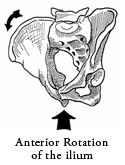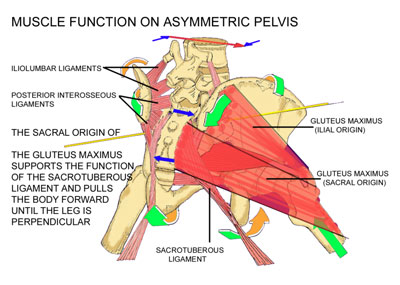SI Joint Dysfunctions
The sacroiliac joint is a weird little dude. Not quite the lumbar spine, so it doesn’t quite follow the same movement parameters as the low back, and it’s not quite in the pelvis so it doesn’t follow the same movement parameters of the hip. This means that it’s kind of caught in the middle, and often overlooked as a means of causing some form of low back pain. Conservative estimates put the occurrence of SI joint pain at around 10-27% of all back pain sufferers, which means there are millions of people walking around with this little bugger giving them grief.
The SI joint is made of 2 main components: The sacrum, or base of the spine, sits in the middle of the structure and looks like a key fitting into a lock. The bony architecture makes it fit pretty tightly with the ridges of the illium, which means the joint has a great design to bear loads, specifically through axial loading. When weight is pressing down into the SI joint, the force of the sacrum driving down into the pelvis causes a compressive force outwards into the pelvis in order to stabilize the load, sort of like how a suspension bridge pushes loads into the cables holding the bridge up instead of having all the load borne by the bridge structure itself. See what I’m talking about by checking the video at 1 minute in.
The joint is designed to rotate in order to allow movement. The sacral rotation occurs along an oblique axis, meaning it’s not straight up and down or side to side, but on an angle. This means that if you’re walking forward with your left foot, it causes a rotation to push your torso forward and swing your right arm to create some rotational momentum to distribute the forces of the pelvis. Unlike Elaine’s nemesis on Sienfeld, you kinda have to walk with your arms swinging.
Here’s the downside. While the SI joint is great at distributing forces from axial loading, it sucks at distributing shear forces, which can be applied by hitting one hip against a solid surface, applying a torque to the pelvis or low back, or creating uneven loading between the two legs. This can result in one or both of the SI joints becoming damaged, and may even leading to a sprain to the ligaments and separation of the bony structures.
 This can lead to a lot of pain and problems with any kind of weight bearing, bending forward, rotation of the pelvis, and pretty much anything. I can remember when my SI joint was bad, simply having something pushing down on my shoulders while standing (like a calf raise, squat, or even a back pack) felt like the hips were being spread and stretched as a result. I cold also feel a change in the bony feel of the SI joint as one of the ischial tuberosities was moved posteriorly. It sucked.
This can lead to a lot of pain and problems with any kind of weight bearing, bending forward, rotation of the pelvis, and pretty much anything. I can remember when my SI joint was bad, simply having something pushing down on my shoulders while standing (like a calf raise, squat, or even a back pack) felt like the hips were being spread and stretched as a result. I cold also feel a change in the bony feel of the SI joint as one of the ischial tuberosities was moved posteriorly. It sucked.
Basic things that can cause some sot of shear in the SI joint, further complicating how you can help and reduce symptoms, includes sitting, standing, laying down, sneezing, coughing, walking, wearing red, eating wheat, and being born a virgo. All kidding aside, SI joint issues can be made worse in pretty much any sustained position, and can be aggravated pretty quickly with sudden movements.
Because the pelvis is responsible for distributing forces from the legs to the torso and vice versa, any alteration in the SI joint can cause a world of hurt. When walking, the weight shifts from one foot to the other, and the SI joint has to rotate to compensate and propel the body forward, which also places a shear force on the spine.
 We can see if there is some sort of mechanical dysfunction in the SI joint by performing a simple marching test.
We can see if there is some sort of mechanical dysfunction in the SI joint by performing a simple marching test.
If the SI joint is too mobile, then it won’t give you the stability needed to resist deformation from any kind of loading or from the basic forces applied to it from walking and normal rotation. What this means is that the bony support system isn’t doing the work its supposed to, and therefore forces the soft tissue system to do all the work. These guys are never enough to do the job, and eventually wind up stretching the ligaments and fascial connective tissue surrounding the area. A downside is that the only muscles that actually cross the SI joint are the multifidus (which has such a moment arm length that it really can’t provide much in the way of movement or handle much stretch), and the lower latissimus fibers (which very few people know how to activate properly).
The remainder of the soft tissue support comes from the thoracolumbar fascia, posterior fascial train, and co-contraction of the supportive fascia between the glutes and contralateral lat muscles. To check out more on the fascial lines and how they intersect at the low back, pick up a copy of Thomas Myers book Anatomy Trains HERE. To see my take on training these systems, I would definitely recommend picking up a copy of Muscle Imbalances Revealed: Lower Body, HERE.
Another big issue with SI joint dysfunction is that posture tends to be altered. The glutes will tighten up hard to try to provide co-contraction stabilization of the area, which pushes the pelvis into a posterior tilt. This pulls the posterior fascial line tight, and also stretches out the lumbar fascia and spinal erectors, making them work harder to maintain support. Since these muscles are already stretched out and possibly weaker, and also because any pain in the low back region causes decreased muscle activity in the core muscles and segmental spinal sections, we have a recipe for an unhappy spine.
What this means for training.
SI joints don’t respond well to saggital plane loading, especially bilateral loading like squats or deadlifts. These movements cause that compressive force that increases shear on the joint, and as the problem is usually unilateral it makes the body compensate and load onto one side more than the other. Boo-urns.
If someone comes in to me complaining of any kind of SI joint pain, I check their pelvic mobility for and hypermobility in the SI joint, and also simply palpate around the SI joint to see if there is any specific tender points or bony deformities. If there are any present, the first thing I want to work on is getting them to selectively activate the supporting muscles around the SI joint in order to gain some additional support and stability. As a result of this, the deformity will also usually go away, and their pain will reduce almost immediately.
Once we have enough stability to support the joint, then we can begin doing light core stability and pelvic mobility drills to re-activate the sleeping core muscles and take some of the tight supportive muscles through a stretch. All core training will be done in as neutral of a spinal position as possible without any pain, and the key will be to create abdominal contractions without causing any kind of hinging in the lumbar spine as a compensation.
Once this is possible, we start working on hip rotation, specifically external rotation strength and internal rotation mobility. The main reason for this is the direct links between glute function (max and medius) and their tie-ins with the SI joint. By working these muscles, they can essentially pull the sacrum up to the level of the iliac crest, which can reduce any kind of hyper mobility in the joint. This is especially true if we can get glute activation with thoracic extension and rotation to activate the spiral line.
Once the glutes can actively contract and completely relax, we can get the person up into standing and work on movements like hip hinging, but with a few caveats. The first being they have to hinge only at their hips, not at their lumbar spine. This is because when the spine goes through flexion, it stretches the posterior fascia that crosses the SI joint and creates more of the shear force we’re trying to avoid, and can also increase the pressure on the lumbar discs pushing backwards, so we’ll cut that out quickly. One way I work through this is to tape the lumbar spine to give some biofeedback as to whether the person is actually flexing from their hips or from their spine.
Once they can get a good range of motion with saggital plane movements without pain, we can begin to work on isolateral movements, such as single leg squats with the elevated leg behind the body (no pistols yet), stepback lunges, 1-foot balance work, loaded carries and other fun variations of these exercises. From there, as long as there is still no pain, we can begin to perform bilateral loading in an upright position, and then finally progress to deadlifts and other lifting patterns.
SI joint injuries, if not trained properly, can result in a lot of the same end result symptoms as disc bulges/herniations or piriformis syndrome, where there is pain radiating down the butt and through the hamstrings. By using a generic training program with SI joint issues, you’ll never solve the problem, primarily because all generic exercise programs assume a strong pelvis. We know this isn’t the case here, so the bony support isn’t there, overstressing the soft tissue structures, which makes any exercise program either painful or impossible to perform safely. Following a systematic process like this will help to reduce pain first, then decrease imbalances, and finally work on mobility and general conditioning of the area, all with feedback from the client as to whether it hurts or not.
A good idea when working with anyone who has suspected SI joint issues is to get them checked out by a qualified physiotherapist or chiropractor. I’ve also had success working with Core Shorts, some of the best coming from Under Armour. These provide compression and resist shear force across the SI joint, which just provides that additional layer of stability.
 Some of the simpler things you could do to decrease irritation in the SI joint include fixing your posture and not slouching as much, trading in the barefoot shoes for something that gives a slight lift to take pressure off the posterior fascial line, and changing positions often to reduce tension through the joint.
Some of the simpler things you could do to decrease irritation in the SI joint include fixing your posture and not slouching as much, trading in the barefoot shoes for something that gives a slight lift to take pressure off the posterior fascial line, and changing positions often to reduce tension through the joint.
These can be a hell of a pain in the butt to work with, but they can be fixed. Sometimes they may require more time and patience, and will have a lot of setbacks if the area is extremely lax, as well as if the person has limited or no control of their spinal segmental control. However, they can be fixed, and the reduction in pain can be a life-changing event to help someone see the real benefit of personal training and specific program design.


20 Responses to SI Joint Dysfunctions